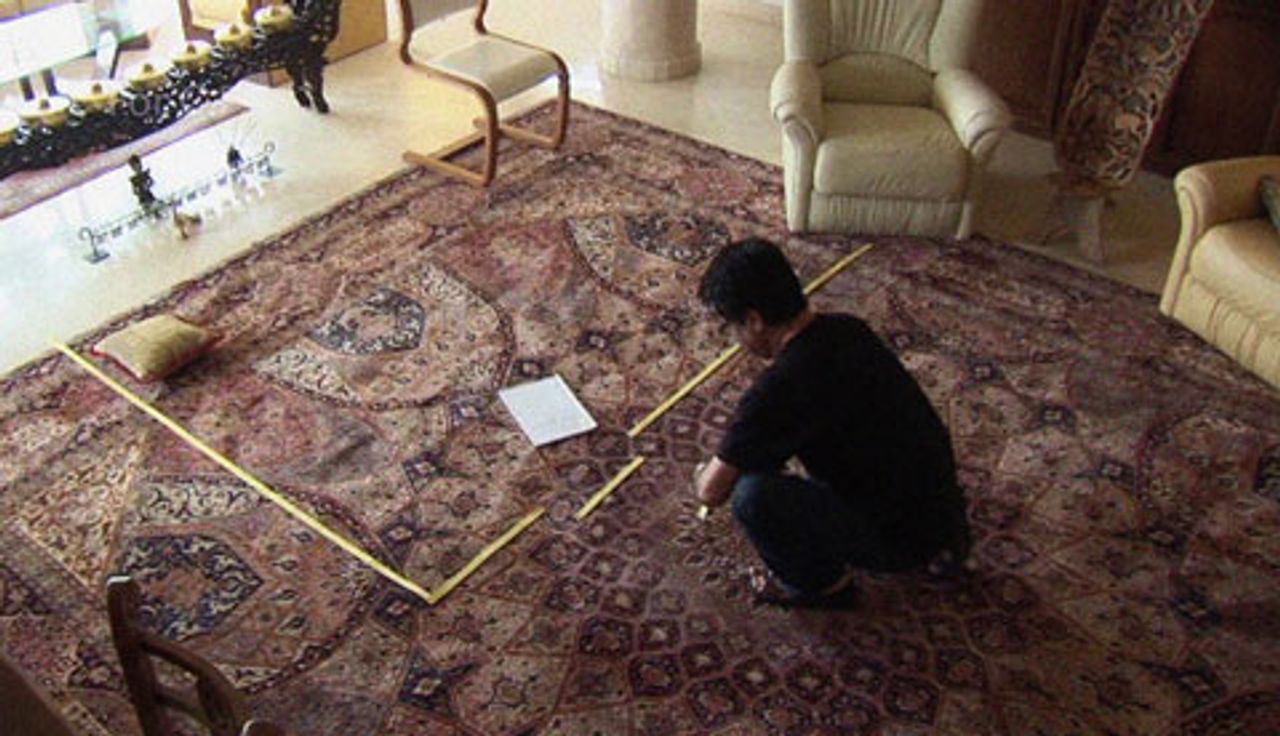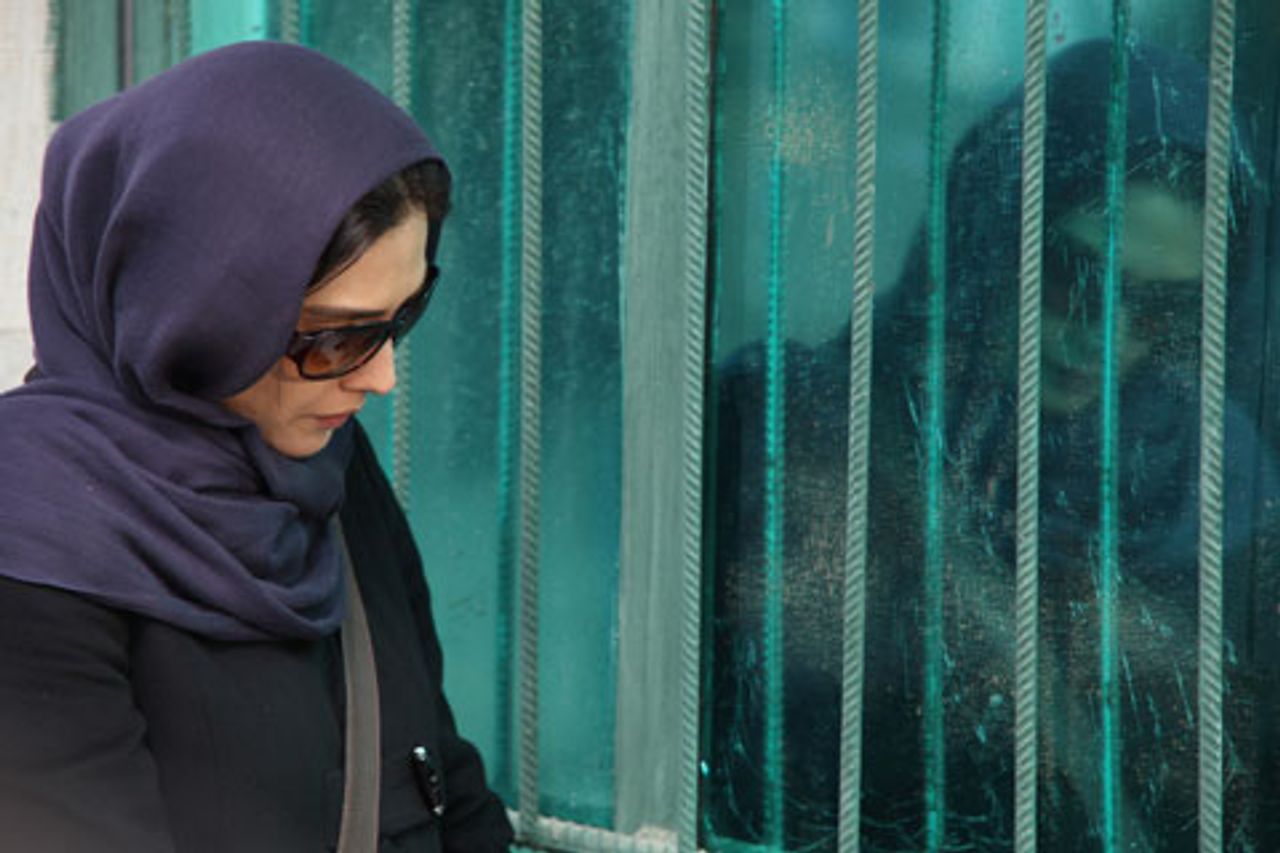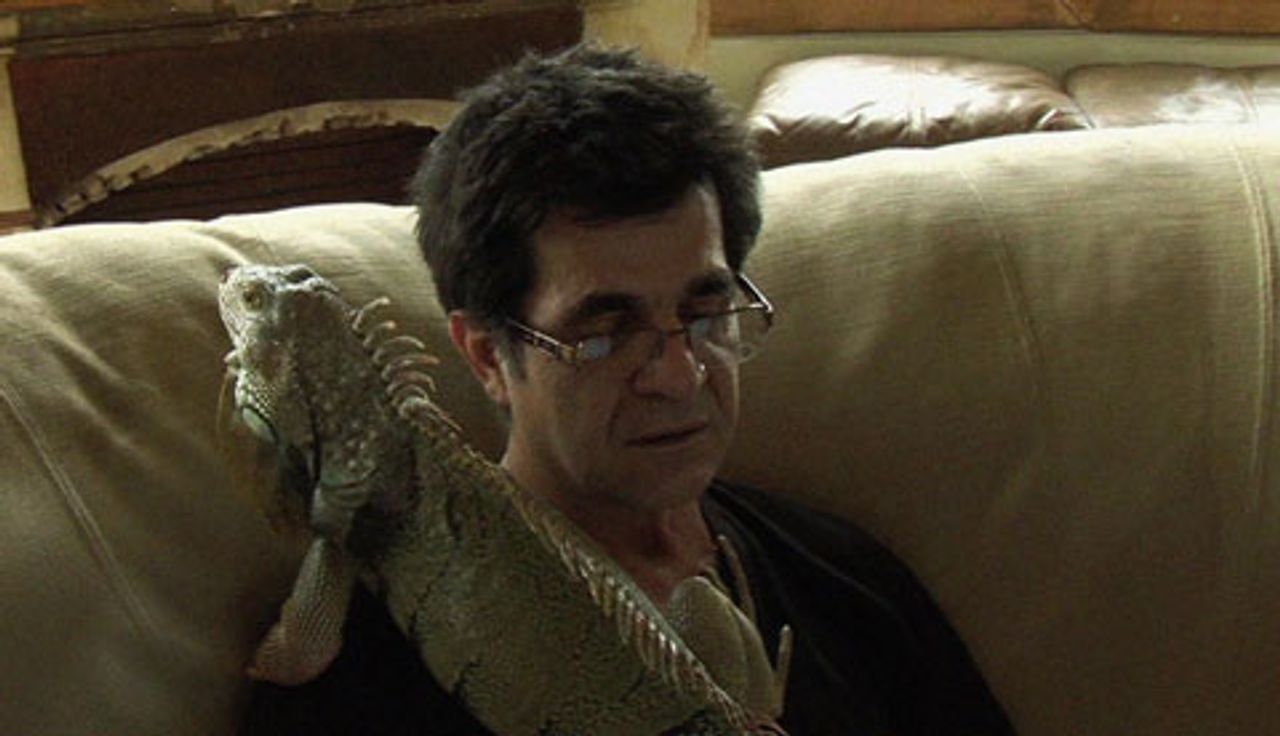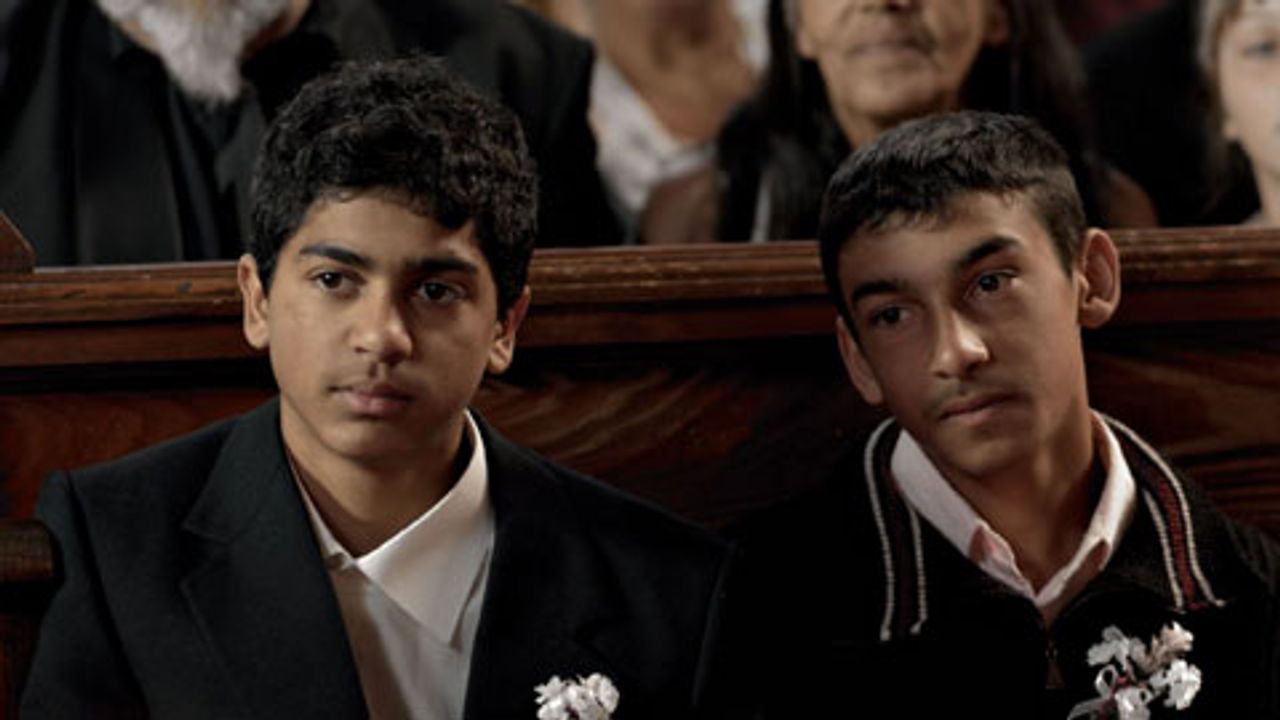This is the last in a series of articles on the recent Toronto International Film Festival. [Part 1][Part 2][Part 3] [Part 4] [Part 5]
The recent Toronto film festival screened several films from Iran—including This is Not a Film, about the house arrest of filmmaker Jafar Panahi, co-directed by Panahi and Mojtaba Mirtahmasb (who was banned from attending the festival by the Iranian government); Good Bye from Mohammad Rasoulof, also undergoing persecution by the Iranian authorities; and Asghar Farhadi’s A Separation. See "Sydney Film Festival 2011—Part 1: Social complexity versus the trivial."
 This Is Not a Film
This Is Not a FilmPanahi and Rasoulof were convicted in December 2010 of acting against Iranian national security, conspiracy to disturb the public peace and safety, and conducting a propaganda campaign against the Islamic regime. They have both been identified with the opposition Green movement.
In October, an appeal by Panahi and Rasoulof against their six-year sentences (in addition, Panahi has been banned from making films for 20 years) was rejected by an appeals court in Tehran, although Rasoulof’s sentence was reduced to one year.
The charges and convictions are thoroughly reactionary, and Panahi and Rasoulof and other victims of this sort of persecution deserve to be defended unequivocally. They are by no means the first Iranian film artists to face this sort of attack. In 2001, Tahmineh Milani was threatened with the death penalty for her film The Hidden Half, which dramatized the repression unleashed against university students by the fundamentalist Islamic regime. Panahi has been brought up on charges on other occasions, and his films banned in Iran.
Six filmmakers and producers—Mirtahmasb, Katayoun Shahabi, Hadi Afarideh, Nasser Saffarian, Shahnama Bazdar and Mohsen Shahrnazdar—were taken into custody by Iranian authorities last month, and charged with working with the BBC Farsi-language service. Actress Marzieh Vafamehr was sentenced to one year in prison and 90 lashes earlier in October for participating in the film My Tehran for Sale.
The suppression of independent Iranian filmmaking has been an ongoing concern of Iran’s clerical rulers.
Resolute defense of Panahi, Rasoulof, Mirtahmasb, Vafamehr and other Iranian film professionals, who are suffering barbaric treatment, should not be taken, however, as an expression of agreement with those who champion the Green movement.
That opposition—headed by former Iranian prime minister Hossein Mousavi, former Majlis (parliament) speaker Medhi Karroubi, and former president Mohammad Khatami, and partly bankrolled by Hashemi Rafsanjani, another former president, the current head of two key state institutions, and reputedly Iran’s wealthiest businessman—represents the interests of disaffected sections of the Iranian ruling elite and upper middle class.
While there is mass discontent with social and political conditions in Iran, the Green movement has little support beyond better-off middle class layers and politically naïve youth who come under their sway. As the WSWS commented in February 2010: “The Green opposition, however, has proven unable and unwilling to make any appeal to the Iranian working class and urban and rural poor. While Green supporters bristle at the mores and dress codes imposed by the Islamic establishment, many are indifferent and downright hostile to the socioeconomic grievances and aspirations of Iran’s toilers. A major complaint of the opposition is that [current President Mahmoud] Ahmadinejad squandered the revenue from the 2005-2008 oil boom on social welfare programs.”
The US and the Western powers, who hypocritically denounce human rights violations in Iran after helping bring to power and supporting the murderous regime of the Shah for decades, viewed the Green protests in 2009 as an opportunity to weaken or bring down the Islamist rulers in Iran and replace them with a government more amenable to their demands. The Obama administration has continued the Bush-Cheney policy of placing relentless pressure on Tehran and creating the conditions in which a military attack on Iran becomes more and more the favored option. The claim of an implausible Iranian-masterminded assassination plot against the Saudi ambassador to the US is only the most recent in a series of provocations.
Unfortunately, the Iranian film artists’ general lack of perspective, as well as their relatively privileged social position, has rendered many of them susceptible to the siren song of the Green forces. Well-known writer-director Mohsen Makhmalbaf has become a virtual roving ambassador for the Green movement, going so far as to publish an op-ed piece in the Wall Street Journal last year headlined “How the West Can Help Iran’s Green Movement,” in which he urged the US to overhaul its Voice of America propaganda broadcasts and praised the comments of French president Nicolas Sarkozy.
Abstract and empty calls for “democracy,” without reference to either the socio-economic conditions of the working population or the imperialist conspiracies, become all too easily absorbed as part of a propaganda campaign suiting the interests of the Great Powers.
The present situation, and the persecution of Panahi and Rasoulof, raise a number of important questions, including the history of our own encounter with Iranian filmmakers.
Kiarostami’s Through the Olive Trees and other works
Iranian filmmaking became a significant international force in the 1980s, in the wake of the revolution that overthrew the Shah and established the Islamic Republic in 1979.
The central contradiction of that historical development, that a mass popular upheaval—due to the absence of revolutionary leadership—resulted in a reactionary, clerical regime coming to power, inevitably found expression in Iranian films. The most interesting filmmakers, secularists and on the political left by and large, turned their attention to the plight of the most oppressed, the marginalized. They did so, however, whether due to external or internal constraints, or both, within relatively narrow confines—a sparse naturalism, virtually no reference to history or direct comment on the wider society, and narratives that often involved children and other vulnerable figures.
We first encountered Iranian cinema in 1994, when the Toronto film festival screened Abbas Kiarostami’s Through the Olive Trees [http://www.wsws.org/articles/2001/jan2001/kiar-o94.shtml], about a young bricklayer persistently wooing a girl whose family disapproves of him. The film’s extraordinary sensitivity and concern for the poor, along with its great aesthetic seriousness, stood in sharp contrast to much of what was being turned out by the global film industry at the time, infatuated with wealth and celebrity.
Other Iranian figures emerged to our view, Makhmalbaf with Salaam Cinema (1995) and A Moment of Innocence (1996); Panahi and his The White Balloon (1995) and The Mirror (1997); Bahman Ghobadi for A Time for Drunken Horses (2000) and Turtles Can Fly (2004); Samira Makhmalbaf with The Apple (1998); Rakhshan Bani-Etemad with The Blue-Veiled (1995) and Under the City’s Skin (2001); and numerous others, including Rasoulof, Parviz Shahbazi, Abolfazl Jalili, Marzieh Makhmalbaf, Rafi Pitts, Babak Payami and Tahmineh Milani.
We interviewed many of these figures, some of them on multiple occasions (Panahi, Kiarostami, Ghobadi and Makhmalbaf), and found them to be intelligent and humane artists. Along with a number of directors and writers from Taiwan, China and South Korea, they represented the best of global cinema in a generally bleak landscape.
However, by the end of the 1990s, the limitations and difficulties began to make themselves felt in a more pronounced fashion. Where would the Iranian approach lead, aesthetically and socially?
In 2001, for example, we wrote from the Buenos Aires film festival that the Iranians’ humanism “has also reached a certain limit. Can they proceed without grasping how the great mass upsurge of 1979 brought to power a thoroughly reactionary regime? Why was there such a vacuum of progressive political forces at that time? What is the history of the Tudeh party and Stalinism in Iran? What was the impact of the Russian Revolution on Iranian intellectuals and artists?”
A shift away from concern with the conditions of the oppressed made itself felt, as film portraits of more self-involved middle class Iranians began to appear. This change reflected growing tensions within Iranian society 20 years after the fall of the Shah, as newly enriched and confident social layers began to look askance at concessions made to the working class and the poor.
For example: Dariush Mehrjui’s Leila (1998), which a commentator singled out for praise because it did not deal with the “simple emotions among poor people” and concentrated on characters who are “freed from the struggle for survival,” and thus could demonstrate “a full range of human emotions and complexities”!
Kiarostami suffered an obvious decline along these lines. We commented in 2002 (in an article on the Toronto festival), in regard to his 10, a “tame and weak” film treating a conversation between a middle class woman and her spoiled son, “The film is not ‘disappointing’ only because one has been expecting Kiarostami to encounter this sort of difficulty, based on the trajectory of his most recent work. The continued refusal of the major Iranian directors to make a serious appraisal of the Iranian revolution, the Islamic regime and other historical and social problems has inevitably led them into something of a blind alley. The Iranians have specialized in intense, intimate and humane dramas, in the particulars of social life. They drew on the democratic impulses which nourished the struggle against the Shah, but which have been brutally suppressed by the reactionary regime in Tehran.
“In the long run, to portray the particular (the specific human relationship or dilemma) in any depth one must be drawing on some degree of understanding of the universal (the state of society and its development as a whole)—or the portrayal, undernourished, loses strength and purpose. The enduring artist sees the relationship of the immediate experience to the experiences of humanity as a whole, grasps both what is unique and what is universal. It is critical that the Iranian filmmakers address the larger issues. The artistic decline is already evident. The same holds true for the Taiwanese and Chinese directors in particular.”
These processes only deepened as the last decade continued, with honorable, socially concerned exceptions, such as Panahi’s Crimson Gold (2003) and Rasoulof’s Iron Island (2005). The plight of Tehran’s middle class professionals, obliged to submit to reactionary social prohibitions, unable to travel freely, cut off from their equally “enlightened” counterparts in the West, and so forth, has increasingly become the focus of Iranian filmmaking. The country’s writers and directors have too often substituted close-ups of angst-ridden faces and gloomy pictures of the caged middle class soul for images of the poor man struggling with life or the abused child.
 Good Bye
Good ByeRasoulof’s Good Bye, screened this year in Toronto, is a case in point. The film preoccupies itself with the discontents of Tehran’s privileged social set. Noora (Leila Zare) is a lawyer whose license has been suspended due to her involvement with a human rights group. Her daily excursions involve visiting government agencies and returning home to a stark apartment where she decorates boxes for an off-the-books income. Venturing into the streets means adhering to rigid constraints imposed on the female population. It eventually becomes clear that Noora’s husband is an oppositional journalist who is fleeing the authorities.
She now intends to leave the country with the help of a black market operation. Plenty of money is needed. In addition, the black marketers insist that having a baby in a foreign country will strengthen her chances of staying in the country. Hard decisions are involved when Noora discovers she is carrying a Down syndrome child.
Noora’s predicament is laid out in the film. Besides the destruction of her career, Noora’s life as a woman is difficult in present-day Iran. On top of restrictions involving dress and social interaction, she is targeted by the government for her husband’s activities.
In one scene, two secret policemen rifle through her apartment, confiscating a broad range of items, including television equipment. Noora’s pet turtle strains in his enclosure for an exit, with clear metaphorical significance. Noora is prepared to forfeit everything, even a husband who is at risk for fighting the regime, to leave Iran. To the question, “Where are you going?” she answers. “What does it matter?” Towards the film’s end, she moans: “If one feels like a foreigner in one’s own country, it is better to be a foreigner in a foreign country.”
Rasoulof chooses a somber, pensive cinematography in which to frame the shots of Noora’s fretful visage. There is way too much of this. Virtually no attention is paid in Good Bye to the lives of ordinary Iranians.
This Is Not a Film, the 75-minute collective effort of Panahi and Mirtahmasb (who wields the camera), takes place almost entirely and somewhat claustrophobically in the former director’s Tehran apartment, as he awaits the outcome of the appeals process. The mundane details of Panahi’s everyday life prevail: he dresses, eats breakfast, feeds his large pet lizard, talks to his mother on the phone. The director calls his attorney: no news yet, but the lawyer thinks he will definitely go to prison. He speaks to another filmmaker about a defense campaign on his behalf.
 This Is Not a Film
This Is Not a FilmThen, Panahi decides to read his latest screenplay, rejected by the authorities, out loud and perhaps act it out. He wants to provide an image “of the film that wasn’t made.” It’s about a girl who’s in love and whose parents lock her up. It mirrors his own situation. The filmmaker uses tape on the rug to mark out the rooms of the imaginary house. After some effort to recreate the proposed film, Panahi stops the process. “If we could tell a film [in words], why make a film?”
He goes back to his computer. There are fireworks and perhaps protests going on outside, in any case, a great commotion. Panahi watches some of it from his balcony. A man arrives to pick up the trash. Significantly, the young man is a graduate in Art Research, who can’t find a job. They talk on the elevator going down, and, finally, we see a shot of the world outside the apartment building: there are bonfires and people running around…is it a riot or unrest?
This Is Not a Film is intelligently and amusingly made, but it inadvertently points to some of the issues raised above. Panahi lives well, high above Tehran’s streets, and he has equipment and conveniences unavailable to the overwhelming majority of the Iranian population. He travels in cultured, artistic circles, who are not facing pressing economic problems. The fictional character the filmmakers create is a university graduate, frustrated by the lack of opportunity in the arts. These are the middle class layers to be found in and around the Green movement.
Iranian filmmaking will only build on its past achievements on a different basis, which has to include the emergence of a left-wing critique of the Islamist elements and open partisanship of the cause of the oppressed. The filmmakers at present have very little to go on.
Final words on a few other films
Life in eastern Slovakia’s Romani settlements is the subject of Slovakian director Martin Sulík’s movie Gypsy. The mostly non-professional cast are Romani who come from terrible poverty and backwardness. Their performances are urgent; one recognizes that there are few opportunities for this segment of society to have its voice heard.
 Gypsy
GypsyGypsy centers around 14-year-old Adam (Ján Mizigár), who after the tragic death of his beloved father, is subjected to cruel indignities at the hands of his new stepfather, his father’s brother. Sulík implies that the uncle’s semi-criminal activities stem from age-old racism and repression against the Romani community. Consequently, shady methods of survival are not unusual or surprising. However, the filmmaker’s vague, humanist politics miss the mark and weaken the film. Sulík wishes for more tolerance and understanding towards the Romani, but avoids condemning the real culprit—a brutal social order.
So, as is the vogue at present, Sulík insisted his film was not political when he addressed the audience after a public screening of Gypsy. He did express, as does his movie, immense sympathy for the approximately 500,000 Romani in Slovakia, of whom 90 percent are unemployed. He further mentioned that the film’s premier brought together some 2,000 Romani and many non-Romani Slovakians.
The Cardboard Village, directed by veteran Italian filmmaker Ermanno Olmi, and Color of the Ocean, from Germany’s Maggie Peren, both address themselves to the terrible situation of African refugees attempting to gain entrance to “fortress Europe.” It is a healthy sign that the filmmakers are appalled and want to convey their concerns and sympathy. However, both films are content to make relatively weak appeals to the liberal consciences of their audience members. The problem does not lie with the supposed indifference or selfishness of ordinary Europeans, but a social system that no longer has any space or use for its most oppressed victims.
Concluded
